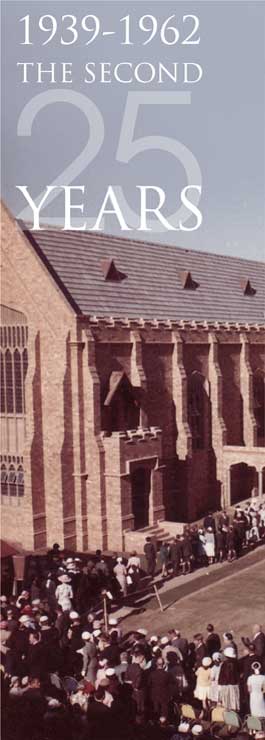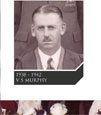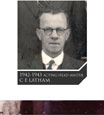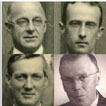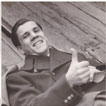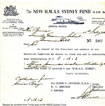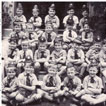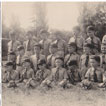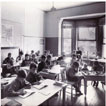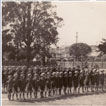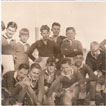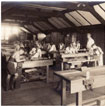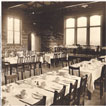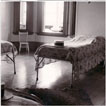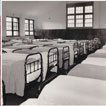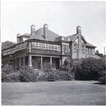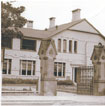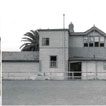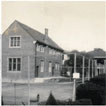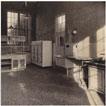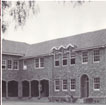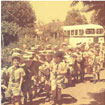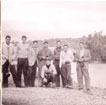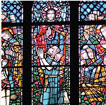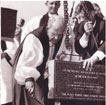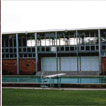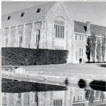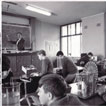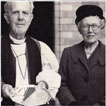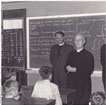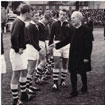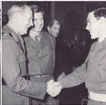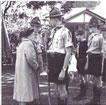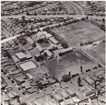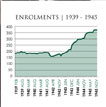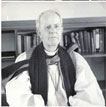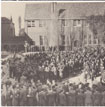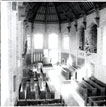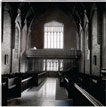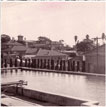BUST
Trinity entered its second quarter century with optimism for the future. The secondary school was now established at Summer Hill after a short residence at Strathfield and the Prep School was developing as a feeder for the secondary years. Redevelopment of the Summer Hill campus had begun - the new Founder’s Building had just been opened and a pool was under construction.
However, troubled times were ahead. Trinity still carried a large debt from the original acquisition of the Summer Hill and Strathfield properties, and with Australia’s declaration of war on Germany, 3 September 1939, enrolments began to fall and financial pressures began to increase. The future became less certain.
Enrolments, which were on the increase in 1938, dropped to just 160 at the beginning of 1942. As the School was wholly dependent on pupil fees for its income, this had a major impact.
Japan entered the War, attacking Pearl Harbour on 7 December 1941, and in February 1942 launched air attacks on Australian ports and airfields in Darwin, Broome, Wyndham and Townsville. Submarines attacked Sydney and Newcastle in May and June the same year. Parents were understandably nervous about sending their children to board at a school less than 6 miles from a major port and airport. In April 1942 the Head Master, Mr Murphy left. The future of the School did not look hopeful.
Meanwhile, the Anglican Diocese was showing reluctance to continue to carry the financial burdens of the School with which they had been assisting. In 1940 a Sub-Committee of the Standing Committee recommended that the School ‘be carried on as a temporary expedient only’. However, members of the School Council worked tirelessly for the survival of Trinity – and backed their words with action. Trinity Councillors and parents, J A Young and C P Taubman, personally guaranteed a large bank loan for the School, and along with T S Holt and A B Kerrigan, periodically gave money to the School to enable it to pay its bills.
In mid-1942, Council members appeared before the Diocesan Standing Committee to argue against the closure of Trinity. ‘Gentlemen, Trinity will be there when all of us are dead’ was reportedly A B Kerrigan’s closing statement, and the Standing Committee left matters in abeyance.
THE TURN OF THE TIDE
The Japanese navy suffered a decisive defeat in the Pacific in June 1942, and Trinity’s fortunes also seemed to be turning.
Enrolments began to recover and increased by 50 during 1943. A significant increase which occurred in September that year was in the form of 18 boarders (most aged under 12) following the closing of Anglewood Boarding School for Boys, Burradoo. They came to Trinity along with their former master Rev P A Byrne, who joined the Preparatory School staff. By the end of the same year, the School Council accepted a recommendation to appoint Mr James Wilson Hogg as the new Head Master, from the beginning of 1944.
Enrolments continued to grow and 1945 opened with an all-time high of 335 boys, with Preparatory pupils outnumbering the Secondary School. These large numbers of younger pupils led to the establishment of a Junior School at Summer Hill in 1946 which, together with the Prep School, continued to outgrow the secondary school for the next ten years, and brought some stability to pupil numbers as boys moved into senior years. Not until 1956 did Secondary pupils outnumber the Prep and Junior School boys.
TRINITY AT WAR
The legislation and regulations of wartime might be ‘a challenge to individualism’ for which we must be prepared ‘in order that our liberties should be preserved’ (The Triangle July 1941).
The School Community banded together to contribute to the war effort. A School Comforts Fund was started by the Sports Master, Mr R S Rankine, to supply parcels of goods to Old Trinitarians serving abroad in the forces. A Comfort parcel sewn up in calico included toothpaste, cigarettes, sweets, shaving cream and brushes, hair oil, combs, soap, boot polish and sewing sets. In 1944 alone, 400 parcels were sent, and mainly paid for by the boys of the School.
The mothers of the School also joined forces to make clothes for children in bombed areas of Britain. With four borrowed sewing machines and a supply of materials, they had made 2,552 garments by the end of 1942.
The School Community also contributed to the general war effort by purchasing War Savings Certificates, and making donations to a range of organisations – the Red Cross, Lord Mayor’s Fund, Naval War Auxiliary, Legacy Club Orphans Fund, Church of England National Emergency Fund (CENEF) and the HMAS Sydney Fund.
The Trinity Dramatic Society donated the proceeds of their performances to these efforts, and in 1941 they also performed for staff and patients at the Randwick General Military Hospital, and the 113th Australian General Hospital, Concord.
In preparation for a possible major emergency, the School Council made enquiries at various rural locations in case evacuation of the School became necessary. Air raid trenches were excavated at Summer Hill in 1942, and a NSW National Emergency Services Aid Post was set up at the Strathfield campus, which was also occupied in the evenings by training classes for RAAF recruits.
The Triangle was cut from three to two issues per year on inferior quality paper (with printing delays). It also printed a list of Old Trinitarians in active service. This list of 70 men in 1940 grew to 271 in total (with 20 killed and 2 still missing in action) in 1946. However, recent research indicates that 42 Old Trinitarians were killed in action and almost 750 saw active service during World War II – a significant proportion of the 1600 or so boys who had attended Trinity since its foundation.
BOARDING INCREASES
The number of boarders also increased dramatically in this quarter century – from 25 in 1942 to 165 ten years later. A former manual arts classroom was turned into West Dorm at the beginning of 1944, and a new Dining Hall and Kitchen were opened on 6 July 1946, followed by an additional second storey dormitory in 1948. Boarding at Trinity reached an all-time high of 187 boys in 1962.
Boarding conditions were not luxurious – cold showers were routine, as was running around the oval in one’s pyjamas before breakfast.
Facilities at the Preparatory School were also expanded to meet the growing needs and in 1946 the School acquired Lauriston at 49 The Boulevarde, Strathfield to house the Junior boarders and the Sub-Primary (Years K-2) classes. A swimming pool was completed at the Prep School in 1952 and new classrooms added in 1956. A long term lease of Bressington Park was secured in 1962.
BOOM - THE 1950s
In the 1950s, Australia experienced a baby boom. Australian industry and agriculture were expanding, and the Snowy Mountains Hydro-Electric Scheme which started in 1949 was to employ over 100,000 workers over the next 25 years. In the previous decade, the student population was already growing in a way that would have an impact on schooling – the NSW compulsory school starting age was reduced from 7 to 6 years and the leaving age raised from 14 to 15. The number of NSW pupils under the age of 14 also grew from 404,000 in 1940 to 525,000 in 1953.
Trinity was not unaffected. Its enrolments continued to increase and the School needed additional facilities. At Summer Hill the main quadrangle began to take shape with construction of classrooms along its third (western) side. The Quad Building was opened in December 1954, and soon after, a reference library was installed in its tower. In 1959 another building on its northern side containing the Head Master’s office completed the Quadrangle.
MEMORIALS
The trials of the previous decade and the War losses were not forgotten by the School. Corporal Geoffrey M White – the first Old Trinitarian war fatality – was commemorated in a Memorial Essay Prize, established in 1941, and Flight Sergeant Kenneth J Taubman, an outstanding Trinity athlete and son of a School Councillor, was memorialised by The Taubman Clock, unveiled in 1945.
The Queensland maple panelling in the Dining Hall was installed by the Old Trinitarians’ Union as a Memorial to the Fallen in 1951 (it also served to cover up the mismatched brickwork – the result of wartime shortages of construction materials).
In 1947 an appeal for a War Memorial Chapel began, and after some years of slow fundraising, the foundation stone was laid on Armistice Day 1956 by the School’s Founder – Bishop Chambers. The Appeal had raised over £40,000 for the Chapel, which was completed and dedicated in November 1957.
NEW TRADITIONS
The School looked forward as well as backward, and the 1950s also saw the establishment of some new traditions.
The Trinity Grammar School Society of the Arts was established in 1951 to expose both the boys and the wider community to music, visual arts and literature. A succession of local and international musicians, dancers and artists visited in those early years.
Music gained a larger place in the School. A Choir had been formed in the 1940s, and with the appointment of a full time music teacher – Mr Noake – the first School Orchestra began (1947) followed by the Cadet Band (early 1950s).
A Prep teacher – John Haslam – formed The Trinity Scout Troop in 1951, initially known as the 2nd Strathfield Boy Scouts. A modest Scout Hall was opened at the Summer Hill campus in 1958.
A major enquiry into NSW education delivered its recommendations in the ‘Wyndham Report’ 1957. One recommendation was that Science be compulsory for all junior secondary pupils. Trinity began its 50th year with the opening of a new Science Building to cater for this change.
END OF AN ERA
Bishop Hilliard (1877-1960), twice Head Master, staunch supporter of the School and for the last 20 years of his life Chairman of School Council, died in 1960. A Memorial Window (below) in the Chapel was dedicated to him on 11 February 1962.
JUBILEE YEAR- 1962
To celebrate its fiftieth year of operation, Trinity invited its Founder, Bishop Chambers, by then aged 84, to attend a week of celebrations. This June week opened and closed with services in the Memorial Chapel, and also included visits by the Founder to the Preparatory School and Junior House (Lauriston), a Prep School drama performance, a Chess afternoon, the dedication of the Jubilee Gates and the Chapel Memorial Court, the presentation of a gift to the Founder, a celebration Rugby match between the Trinity First XV and The King’s School, an exhibition of paintings by artist and staff member Billie Wallace, a concert presented by the Society of the Arts, a Ceremonial Cadet Parade – reviewed by Sir Eric Woodward, Governor of NSW, and a review of the Scouts by Mrs Chambers.
From the outdoor pulpit of the Memorial Chapel, the Founder addressed a flourishing School that was more than thirty times the size of the one he had seen on its very first day in 1913, and heard the concluding cheer reverberating around the Quadrangle from a School a thousand strong.
THE SECOND 25 YEARS
- 1939 – 12 staff and 196 pupils
- 1962 – 54 teaching staff and 995 pupils
- 3 Locations; Summer Hill and Strathfield (Llandilo and Lauriston)
- 2 Head Masters
- Boarding grew from 25 boys in 1939 to an all-time high of 187 in 1962
- Trinity reaches 1,000 students in February, 1961
- Approximately 1,320 boys had passed through Trinity by end of 1938
- In the second 25 years another 2,760 boys passed through Trinity
- By the end of the first 50 years of Trinity Grammar School there were approximately 4,000 Old Trinitarians.
Source: The School Archives
